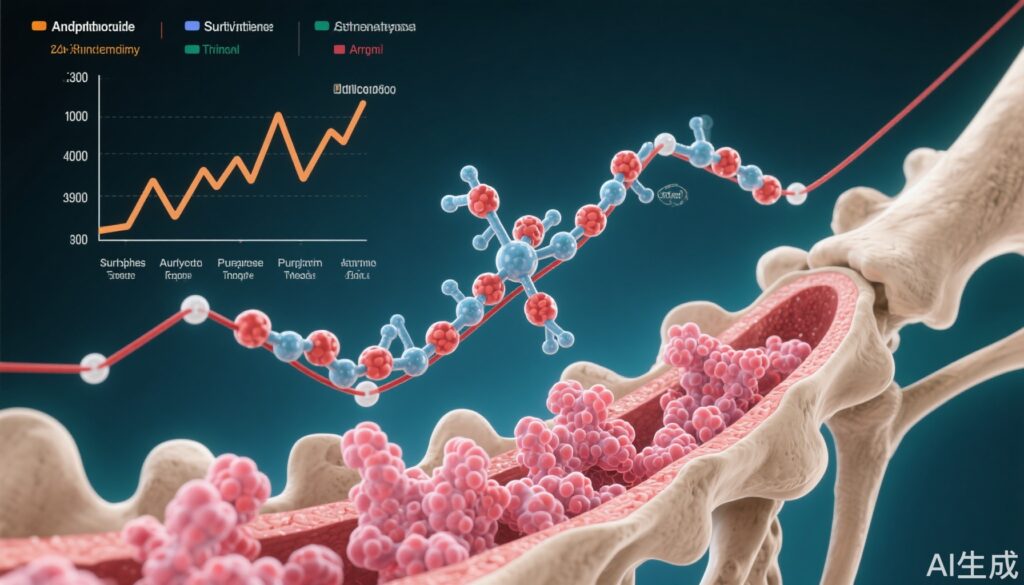Highlights
- Belantamab mafodotin combined with bortezomib and dexamethasone (BVd) achieved significant overall survival gains versus daratumumab-based therapy (DVd) in relapsed or refractory multiple myeloma (RRMM).
- BVd more than doubled the rate of minimal residual disease (MRD) negativity and extended duration of response compared to DVd.
- Safety profile is notable for thrombocytopenia and ocular toxicity, but these events were generally manageable.
- Real-world data support the efficacy of belantamab mafodotin, even in heavily pretreated and high-risk populations.
Clinical Background and Disease Burden
Multiple myeloma (MM) is a malignant plasma cell disorder characterized by repeated cycles of relapse and remission. Despite advances in therapy—including proteasome inhibitors, immunomodulatory agents, and monoclonal antibodies—most patients ultimately develop relapsed or refractory disease (RRMM), which is associated with poor prognosis and high clinical unmet need. The introduction of anti-CD38 antibodies (e.g., daratumumab), bortezomib combinations, and novel agents has improved outcomes; however, resistance and toxicity remain major challenges, highlighting the need for innovative therapies targeting new myeloma vulnerabilities.
Belantamab mafodotin is an antibody-drug conjugate targeting B-cell maturation antigen (BCMA), a protein highly expressed on malignant plasma cells. Building on promising results in early-phase studies, DREAMM-7 investigates whether belantamab mafodotin, when combined with bortezomib and dexamethasone, can further improve clinical outcomes in RRMM compared to a daratumumab-based regimen.
Research Methodology
The DREAMM-7 trial is a global, open-label, randomized, phase 3 study conducted at 142 centers across 20 countries. Eligible patients were at least 18 years old, had confirmed MM per International Myeloma Working Group criteria, ECOG performance status 0–2, and had progressed after at least one prior therapy. Patients were randomized 1:1 to BVd (belantamab mafodotin 2.5 mg/kg IV every 3 weeks + bortezomib 1.3 mg/m2 SC twice weekly for up to 8 cycles + dexamethasone 20 mg oral/IV) or DVd (daratumumab 16 mg/kg IV on a standard schedule + bortezomib and dexamethasone as above). Randomization was stratified by prior treatments and disease stage. Treatment continued until progression, death, unacceptable toxicity, or withdrawal.
The primary endpoint was progression-free survival (PFS); key secondary endpoints included overall survival (OS), MRD negativity in patients with complete response or better, duration of response, and safety. Analyses were intention-to-treat.
Real-world evidence was gathered from Memorial Sloan Kettering Cancer Center, evaluating 94 patients treated with commercial belantamab mafodotin (2020–2023), most of whom had high-risk disease and were refractory to multiple drug classes.
Key Findings
At a median follow-up of 39.4 months, the updated interim DREAMM-7 data show:
- Median OS was not reached (NR) in the BVd group and was NR (41.0 months–NR) in the DVd group. Hazard ratio (HR) for OS was 0.58 (95% CI 0.43–0.79; p = 0.0002), indicating a 42% reduction in risk of death with BVd.
- MRD negativity rates among patients achieving complete response or better were 25% (BVd) vs 10% (DVd), suggesting deeper remissions with BVd.
- Median duration of response was 40.8 months (BVd) vs 17.8 months (DVd).
- Progression-free survival 2 (PFS2), which includes time to progression on next-line therapy, was NR for BVd (95% CI 45.6–NR) vs 33.4 months (DVd), HR 0.59 (95% CI 0.45–0.77).
- Grade 3 or 4 thrombocytopenia was more common in BVd (56%) than DVd (35%). Serious adverse events (SAEs) occurred in 53% (BVd) vs 38% (DVd), with pneumonia, pyrexia, and COVID-19 being the most frequent.
- Treatment-related deaths were infrequent but higher in the BVd arm (3% vs 1%).
Real-world data from Memorial Sloan Kettering Cancer Center provides important corroborative evidence:
- Overall response rate (ORR) to belantamab mafodotin was 43%, with 21% achieving very good partial response or better. Median PFS was 3.8 months and median OS was 17.2 months in a heavily pretreated cohort (median 6 prior lines; 82% triple-class refractory).
- Ocular toxicity (keratopathy) occurred in 65%, but was reversible and manageable with dose modifications.
- Even in patients with prior BCMA-directed therapy, ORR was 29% and median OS was 20.4 months, reflecting persistent activity in difficult-to-treat populations.
- Serious infections were uncommon.
Expert Commentary
Leading myeloma experts have highlighted the clinical impact of DREAMM-7, particularly the magnitude of OS benefit and depth of response. The doubling of MRD negativity rates with BVd is notable, as MRD status is predictive of outcome in myeloma. The trial’s outcomes position BVd as a compelling alternative for patients after first relapse, especially for those ineligible for anti-CD38 re-treatment or with aggressive disease biology.
While the efficacy data are robust, notable safety concerns include hematologic toxicity and ocular adverse events. The latter, although manageable, require vigilant monitoring and may necessitate dose interruptions or reductions. Real-world data show slightly lower response rates and shorter PFS compared to the trial, likely reflecting more heavily pretreated and frailer populations. Additionally, the open-label design could introduce some bias, although endpoints such as OS and MRD negativity are less susceptible.
Generalizability may be limited by the predominance of White participants (83%) and exclusion of patients with poor performance status (ECOG >2). Long-term safety, especially regarding cumulative toxicities and quality of life, needs further assessment.
Conclusion
The DREAMM-7 trial establishes belantamab mafodotin plus bortezomib and dexamethasone as a new benchmark in RRMM, demonstrating significant and sustained improvements in survival, MRD negativity, and response durability over standard daratumumab-based regimens. Real-world data confirm its utility in more refractory and high-risk populations. Ongoing vigilance regarding toxicity, especially ocular events, is essential. Future studies will clarify optimal sequencing, combinations, and patient selection for BCMA-targeted therapy.
References
1. Hungria V, Robak P, Hus M, et al. Belantamab mafodotin plus bortezomib and dexamethasone in patients with relapsed or refractory multiple myeloma (DREAMM-7): updated overall survival analysis from a global, randomised, open-label, phase 3 trial. Lancet Oncol. 2025 Aug;26(8):1067-1080. doi: 10.1016/S1470-2045(25)00330-4 IF: 35.9 Q1 .2. Hultcrantz M, Derkach A, Hassoun H, et al. Belantamab mafodotin in patients with relapsed/refractory multiple myeloma: a real-world experience. Blood Neoplasia. 2025 Apr 16;2(3):100103. doi: 10.1016/j.bneo.2025.100103 . PMID: 40575079 ; PMCID: PMC12197964 .



